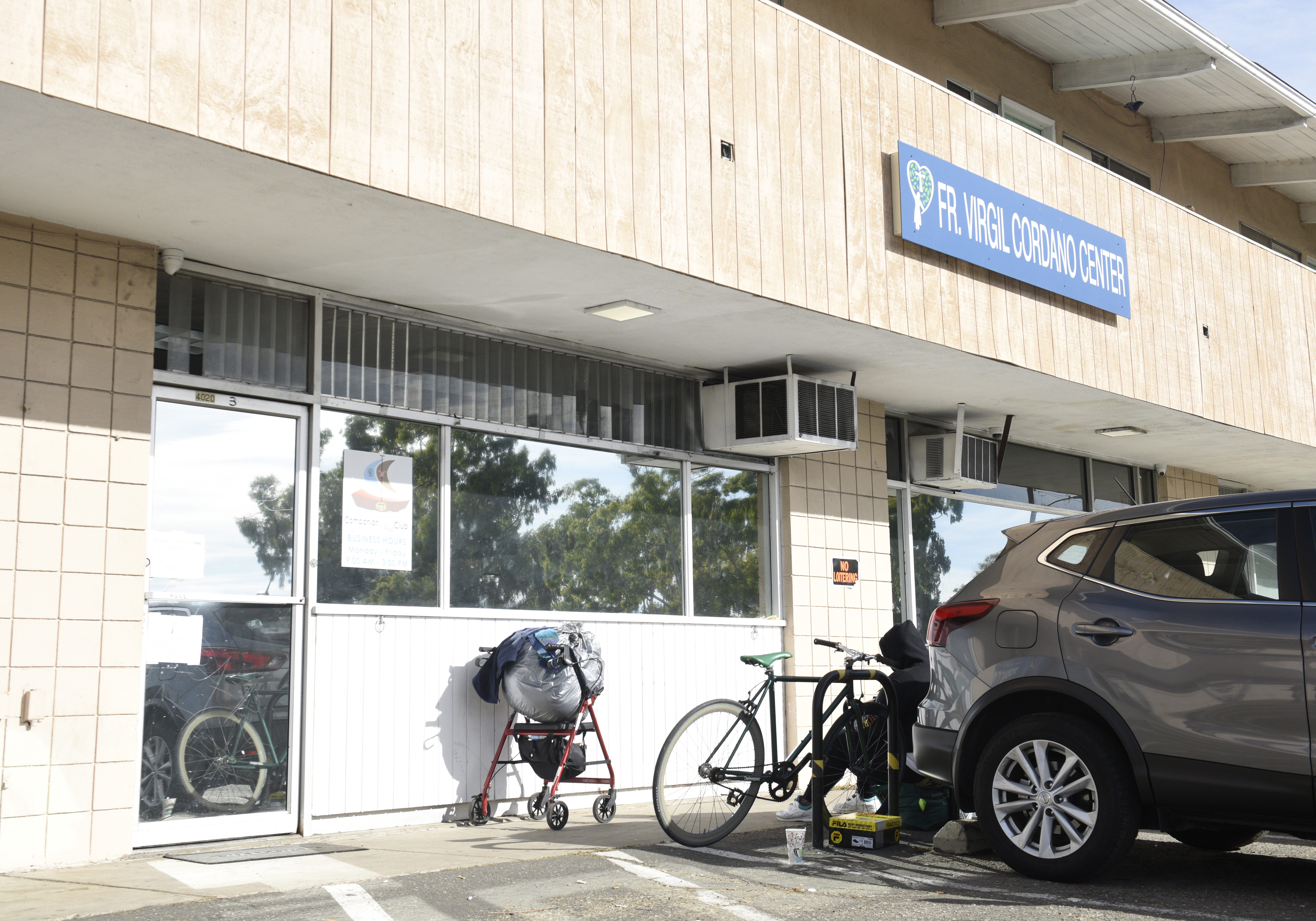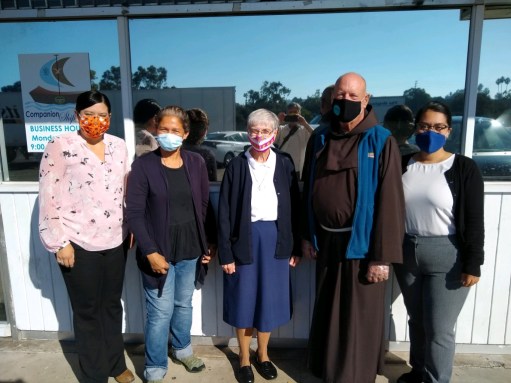Santa Barbara’s Virgil Cordano Center Hits the Streets
With Day Center Shuttered by COVID, Volunteers and Staff Go Mobile

It’s early Monday morning, and somewhere inside a run-down, frayed-at-the-edges strip mall populated by a gun shop, a liquor store, a “Chinese” massage parlor, and a vape shop, a nun and a priest are hard at work — accompanied by about 10 spiritually like-minded volunteers and staff — putting together 140 hot lunches for people living on the streets.
Brown bags — stout and sturdy — are lined up in rows like soldiers on parade. Generous slabs of freshly made meatloaf are ladled into white takeout boxes, as are mashed potatoes and steamed broccoli. Hard-boiled eggs are placed into plastic Ziploc bags, as are two slices of bread. All this and bottled water is inserted into the brown bags, which are in turn placed in insulated carrying containers as big as a small duffel bag. These containers — and the volunteers — then pile into a brand-new van, and at 11 a.m. the distribution of the food begins at Pershing Park, Alameda Park, Chase Palm Park, the waterfront, and more recently, at Girsh Park. All this — and considerably more — takes place three times a week.
At work is the reincarnation and transformation of the Fr. Virgil Cordano Center, which for nearly two years ranked as one of the best-kept secrets in Santa Barbara. For years, homeless advocates and social service crusaders have called for the creation of a day center to provide a waystation to provide both services and respite for people on the street.
Get the top stories in your inbox by signing up for our daily newsletter, Indy Today.
Given Santa Barbara’s not-in-my-backyard politics, the very idea of day centers proved mythically elusive. Very quietly — and with no request of public funds — Fr. John Hardin, a Franciscan priest from the Santa Barbara Mission, teamed up with Sister Margaret with the Daughters of Charity — affiliated with St. Vincent’s de Paul — and together, they opened the Fr. Virgil Cordero Center, whose off-the-beaten-track location on Calle Real no doubt helped keep controversy at bay.

Hardin, who was assigned to Santa Barbara’s Mission four years ago, has executive chops that could be highly relevant for Santa Barbara’s expansive constellation of organizations serving the homeless. For seven years, Hardin served as executive director of St. Anthony’s in San Francisco’s notorious Tenderloin. For several years after, he served on its board.
On Monday, Hardin wore a St. Anthony’s face mask, noting that in the nonprofit’s 70 years, the organization had dished out no fewer than 48 million meals to people seriously down on their luck. “And with not one cent of government funding,” he added.
The Virgil Cordano Center opened December 2018. By the time COVID put the center out of business earlier this year — there wasn’t enough space inside for the necessary social distancing — it had opened its doors to about 40 people a day, 240 members in all. These members took advantage of the center’s 13 recliners to get some sleep or just relax. The center provided two feet-washing stations, breakfasts, mail service, a washer and dryer, charging stations for cell phones, and a Wi-Fi internet connection.
It also created a space where companionship was possible.
It remains unclear whether COVID will let the center reopen. But in recent months, the people who made the day center happen decided it was time to take their show on the road. Hence, the genesis of the brown bag program.
Initially, the menu was scattershot, depending almost entirely on whatever Lazy Acres, Trader Joe’s, or the Foodbank had on hand to donate. But more recently, the day center has hooked up with industrial kitchens at UCSB, which received federal stimulus grant money to keep food service workers who would otherwise be unemployed still cooking. That grant, however, expires sometime in December.
The van was procured courtesy of the Berry Man, the Knights of Malta, and the Montecito Bank & Trust.
In addition to the lunches, the day center delivers mail to 25 members and offers its homeless clients access to a laundromat in San Roque two mornings a week — and all the quarters and soap needed. With daylight saving time over, nights are getting darker —and colder — sooner. The center is preparing to launch its third annual sleeping-bag donation drive. Last year, it managed to pass out 250.
The need, program director Cynthia Estrada noted, is only growing greater. People are losing their jobs or having hours cut. Since the center shut its doors, it has signed up 30 new members. She, like many who work with homeless people, is struck by the growing number of people living in their cars. Estrada estimated 20 of the new members are car dwellers. She speaks of a son and his mother who travel together on the streets, each in their own car.
“Winter is coming,” she said. “We’ll be seeing more tents. It’s getting colder, and people need to stay warm.”
In the short term, Estrada juggles the schedules of about 20 volunteers a week. In the long term, it’s part of her job to worry what the long term will be. The center’s lease expires next August. The Franciscans and the Daughters of Charity, she said, are hoping to find more spacious accommodations, preferably with apartments upstairs that would accept federal housing vouchers. Ideally, she said, she’d like some open space, enough to plant and harvest a garden.
Estrada and a volunteer made the rounds at Alameda Park, where there are numerous but small clusters of homeless people dispersed throughout. She hauled along a bright-green wagon, passing out the brown bags and exchanging a few pleasantries with people she’s gotten to know.
Several of the recipients politely declined to be interviewed. Others, like a guy named Lefty, seated at a picnic table, announced he would not be accepting the food. “I’m not a little boy,” he explained. “I can feed myself.”
Lefty, originally from Hell’s Kitchen in New York City, added, “These are the most pampered bunch in the country, and you can quote me on that.”
His companion, James Johnson, termed the meal “great,” but not before holding aloft a book by noted ’60s media critic Marshall “The medium is the message” McLuhan, demanding, “Do you know who he is?” He would later do the same with Susan Sontag’s Regarding the Pain of Others, an aesthetic rumination on how human suffering is depicted in the arts.
Estrada works quickly and smoothly, however, and does not get bogged down in such exchanges. She has other parks to be at.
CORRECTION: An earlier version of this story incorrectly referred to the Daughters of Charity as the Sisters of Charity.
Every day, the staff of the Santa Barbara Independent works hard to sort out truth from rumor and keep you informed of what’s happening across the entire Santa Barbara community. Now there’s a way to directly enable these efforts. Support the Independent by making a direct contribution or with a subscription to Indy+.




You must be logged in to post a comment.